Abstract
In Japan’s winter-spring spinach agriculture, based on data from 1994, the maximum yield nationwide was 346kt, the maximum cultivated area was 24.4kha, and the maximum shipping volume was 35.9kt in Saitama. These figures show that winter/spring spinach is one of the important leafy stem vegetables in Japan. Saitama Prefecture in particular leads in terms of shipping volume, suggesting that cultivation in the region is thriving. In addition, there is not much difference in harvest volume and cultivated area across the country, so production efficiency is likely to be relatively high. However, this data is based on 1994 and may not reflect the current situation.
Winter-spring spinach harvest yields (main data).
Based on data from 1973 to 1994, Japan’s winter-spring spinach harvest peaked nationwide in 1987, reaching 386 kt. However, yields have since declined and are now at 89.6% of their peak. This trend indicates a change in factors affecting demand and production conditions for winter-spring spinach. One possibility is that increased demand for other vegetables and leafy greens has prompted farmers to diversify their crops. It is also possible that production efficiency has increased due to improvements in agricultural technology and cultivation methods. These trends suggest that Japanese agriculture is changing and attempting to adapt to new market needs and environments.
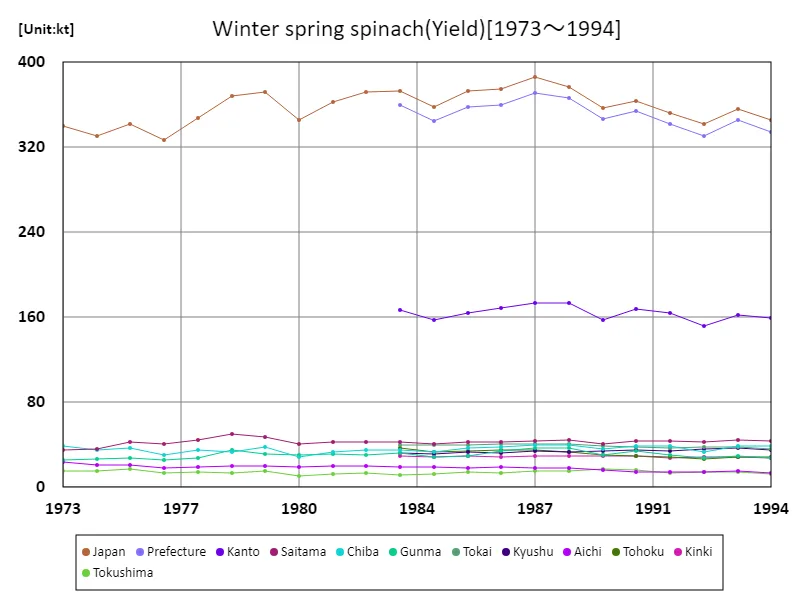

The maximum is 386kt[1987] of Japan, and the current value is about 89.6%
Winter-spring spinach harvest volume (by prefecture).
Based on the latest data from 1994 regarding the yield of leafy vegetables in Japan, it is clear that Saitama Prefecture is the largest in the nation. The figure of 43.6kt indicates that Saitama Prefecture plays a very important role in leafy vegetable production. This suggests that Saitama Prefecture may have climate and land conditions suitable for cultivating leafy vegetables. We can also see that Saitama Prefecture has an exceptionally high harvest yield compared to other prefectures. This is believed to be the result of local farmers and agricultural organizations proactively improving cultivation techniques and management methods and building efficient production systems. Additionally, Saitama Prefecture’s proximity to markets with higher demand for leafy vegetables compared to other regions may also be a factor. In this way, Saitama Prefecture’s highest leafy vegetable harvest demonstrates the characteristics and advantages of the region’s agriculture.
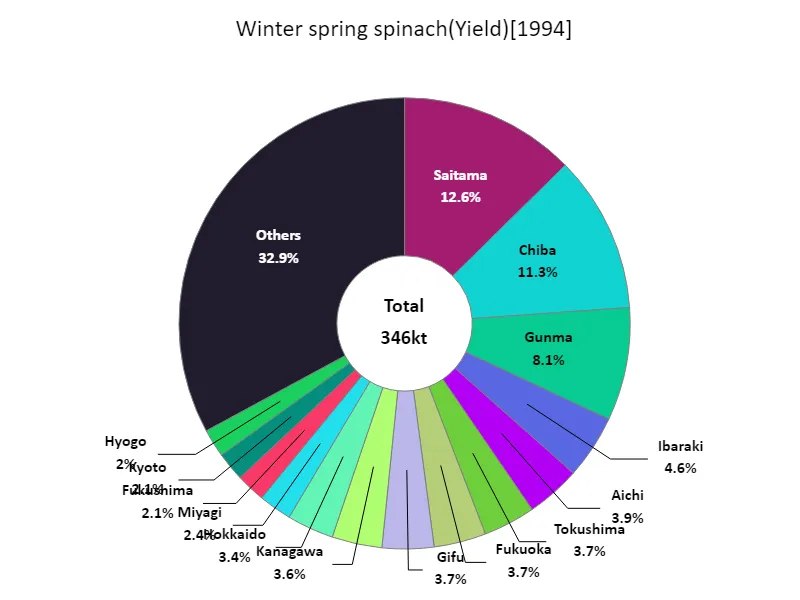

The maximum is 43.6kt of Saitama, the average is 7.35kt, and the total is 346kt
Area planted with winter/spring spinach (main data).
Based on data from 1973 to 1994, the area planted to winter-spring spinach in Japan peaked nationwide in 1987, reaching 25.6 kha. Since then, the area under cultivation has decreased slightly and is currently at 95.3% of its peak. This trend indicates a change in factors affecting demand and production conditions for winter-spring spinach. One possibility is that increased demand for other vegetables and leafy greens has prompted farmers to diversify their crops. It is also possible that improvements in agricultural technology and cultivation methods have made it possible to produce greater yields from the same amount of land. These trends suggest that Japanese agriculture is changing and attempting to adapt to new market needs and environments.
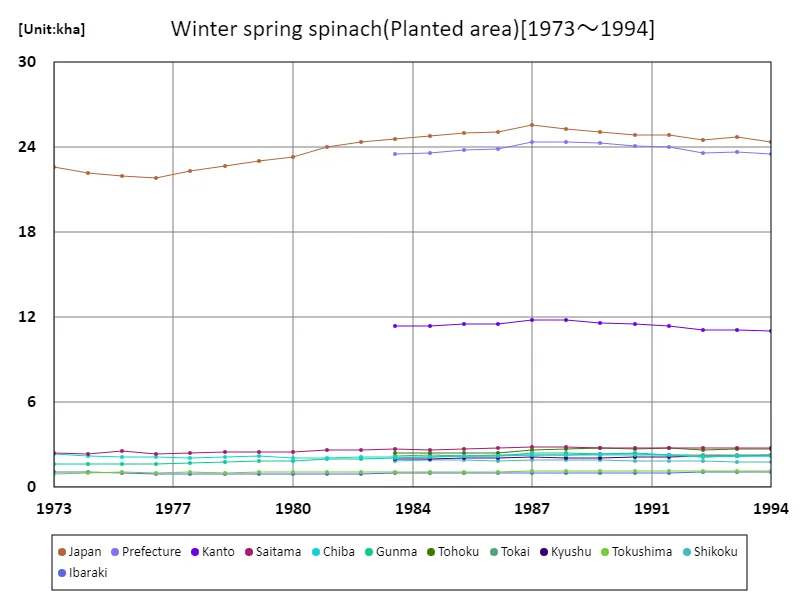

The maximum is 25.6kha[1987] of Japan, and the current value is about 95.3%
Areas planted with winter/spring spinach (by prefecture).
According to data from 1994, the largest area cultivated with leafy vegetables in Japan was Saitama Prefecture, at 2.79 kha. These figures indicate that Saitama Prefecture is a particularly important region for the cultivation of leafy vegetables. It can be seen that Saitama Prefecture has an exceptionally high cultivated area of leafy vegetables compared to other prefectures. This is believed to be the result of local farmers and agricultural organizations proactively improving cultivation techniques and management methods and building efficient production systems. Another factor may be that Saitama Prefecture is closer to markets with higher demand for leafy vegetables than other regions. Furthermore, Saitama Prefecture’s geographical location is ideal for cultivation, which may have contributed to maximizing the area under cultivation. In this way, the fact that Saitama Prefecture has the largest area planted with leafy vegetables demonstrates the characteristics and advantages of the region’s agriculture.
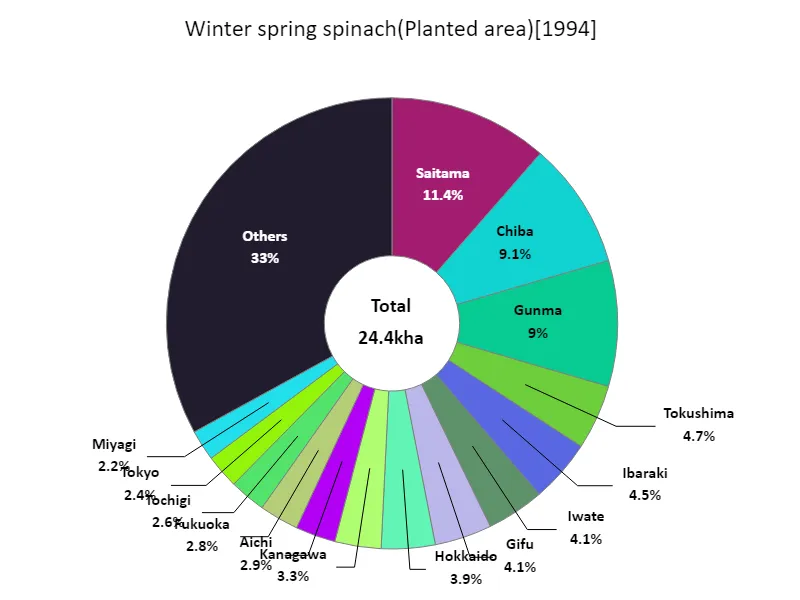

The maximum is 2.79kha of Saitama, the average is 520ha, and the total is 24.4kha
Winter/spring spinach shipping volume.
According to data from 1994, the total winter/spring spinach shipment volume for Japan was 274kt, of which Saitama Prefecture accounted for 35.9kt. The overall average shipping volume was 5.82kt. These figures clearly show that Saitama Prefecture has an exceptionally high share of winter/spring spinach shipping volume. We can see that Saitama Prefecture produces more winter and spring spinach than other prefectures. This may be because the local climate and land conditions are suitable for growing winter-spring spinach, and local farmers may be using advanced cultivation techniques and management methods to optimize production. Additionally, the overall average shipment volume of 5.82kt suggests that demand for winter-spring spinach is relatively stable. This data indicates that Saitama Prefecture is a major producer of winter-spring spinach and plays an important role in Japan’s winter-spring spinach supply.
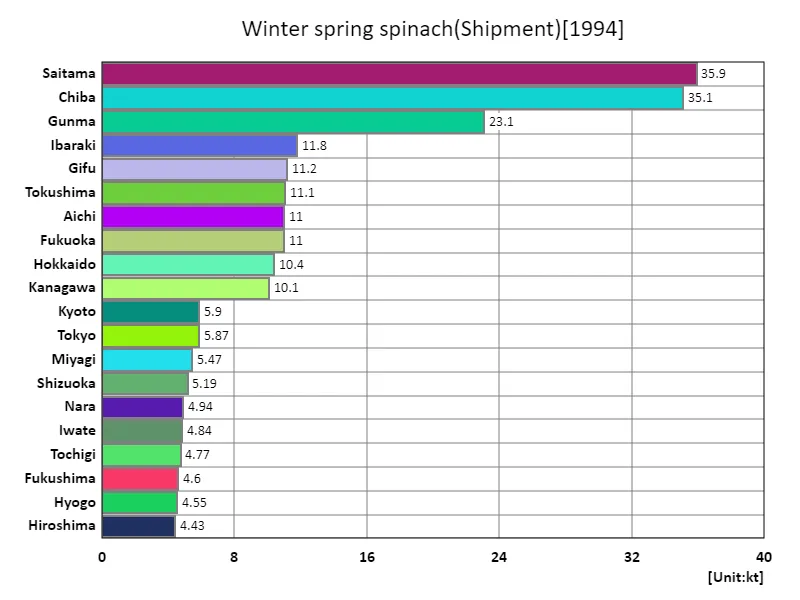

The maximum is 35.9kt of Saitama, the average is 5.82kt, and the total is 274kt
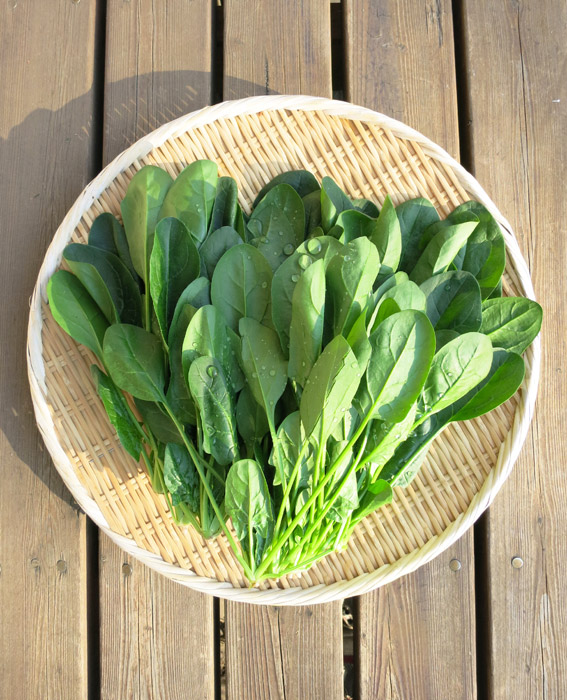


Comments